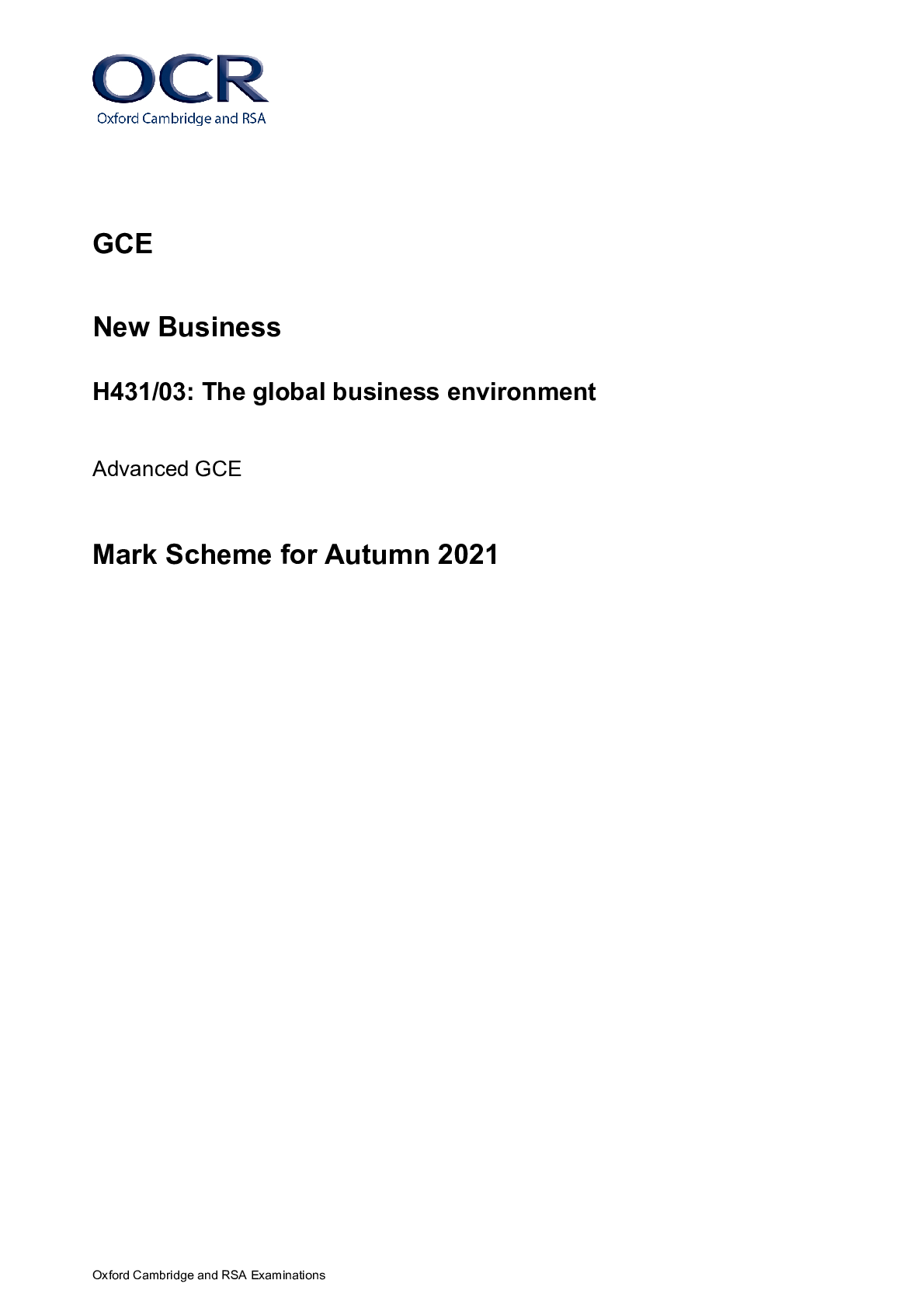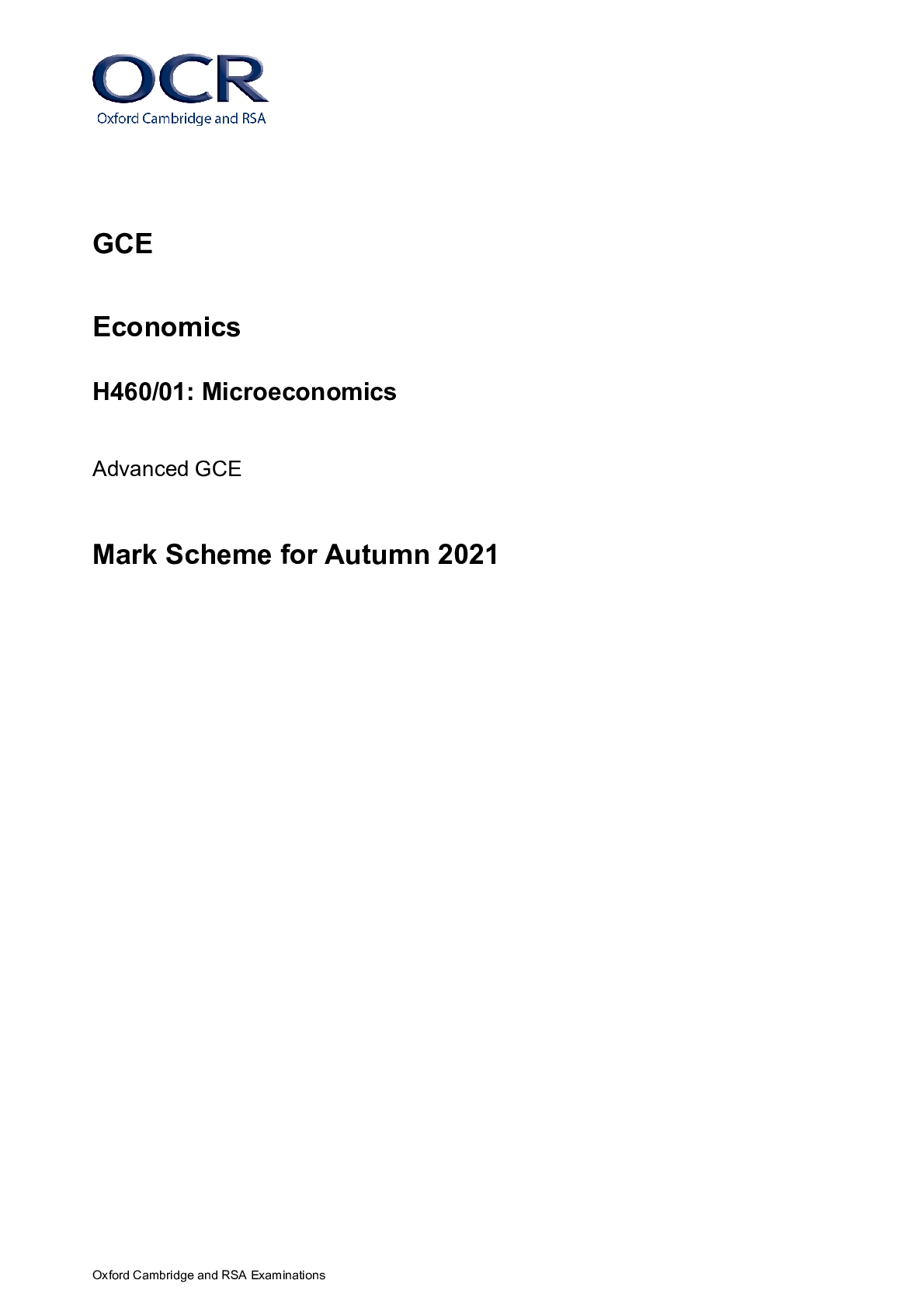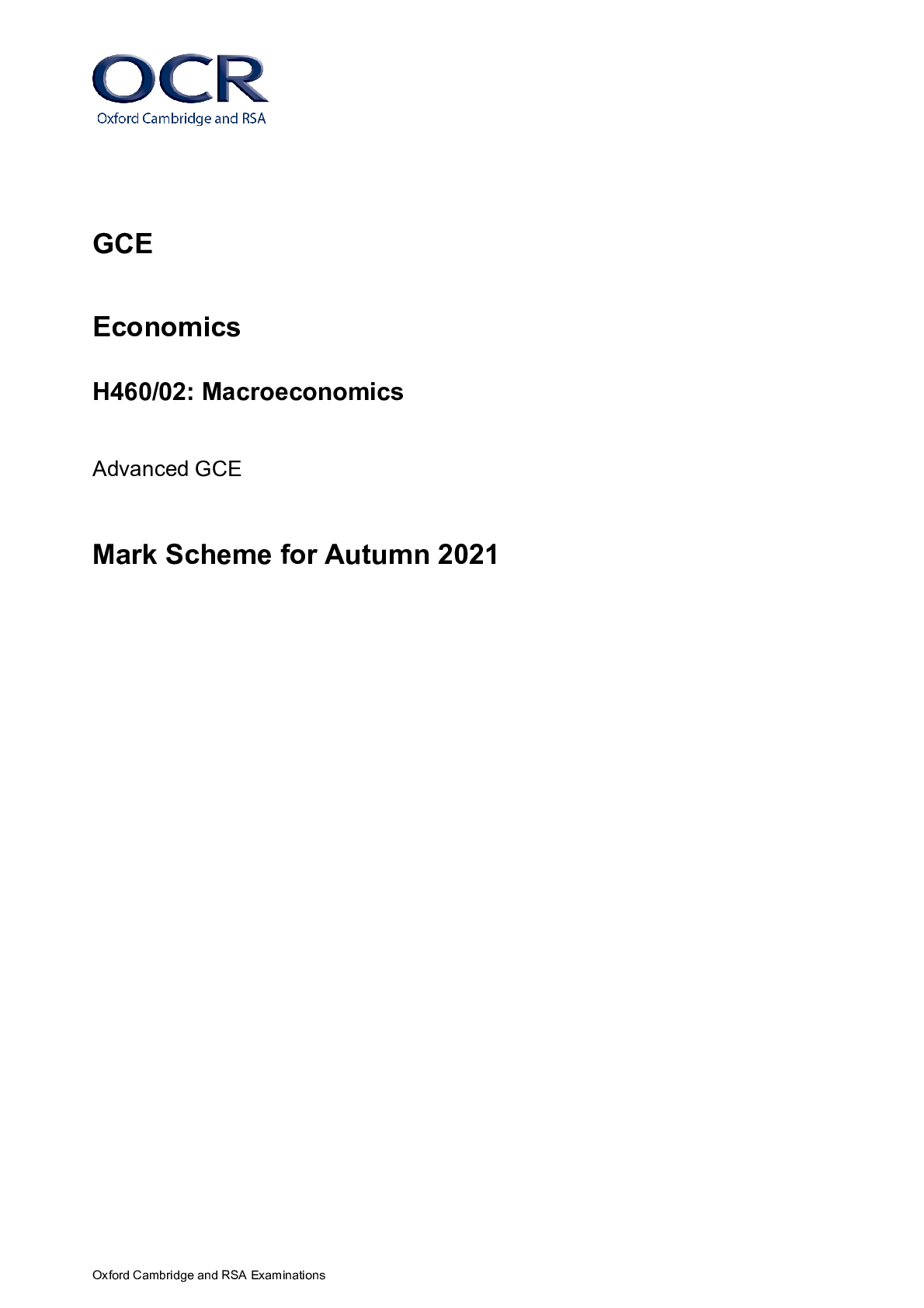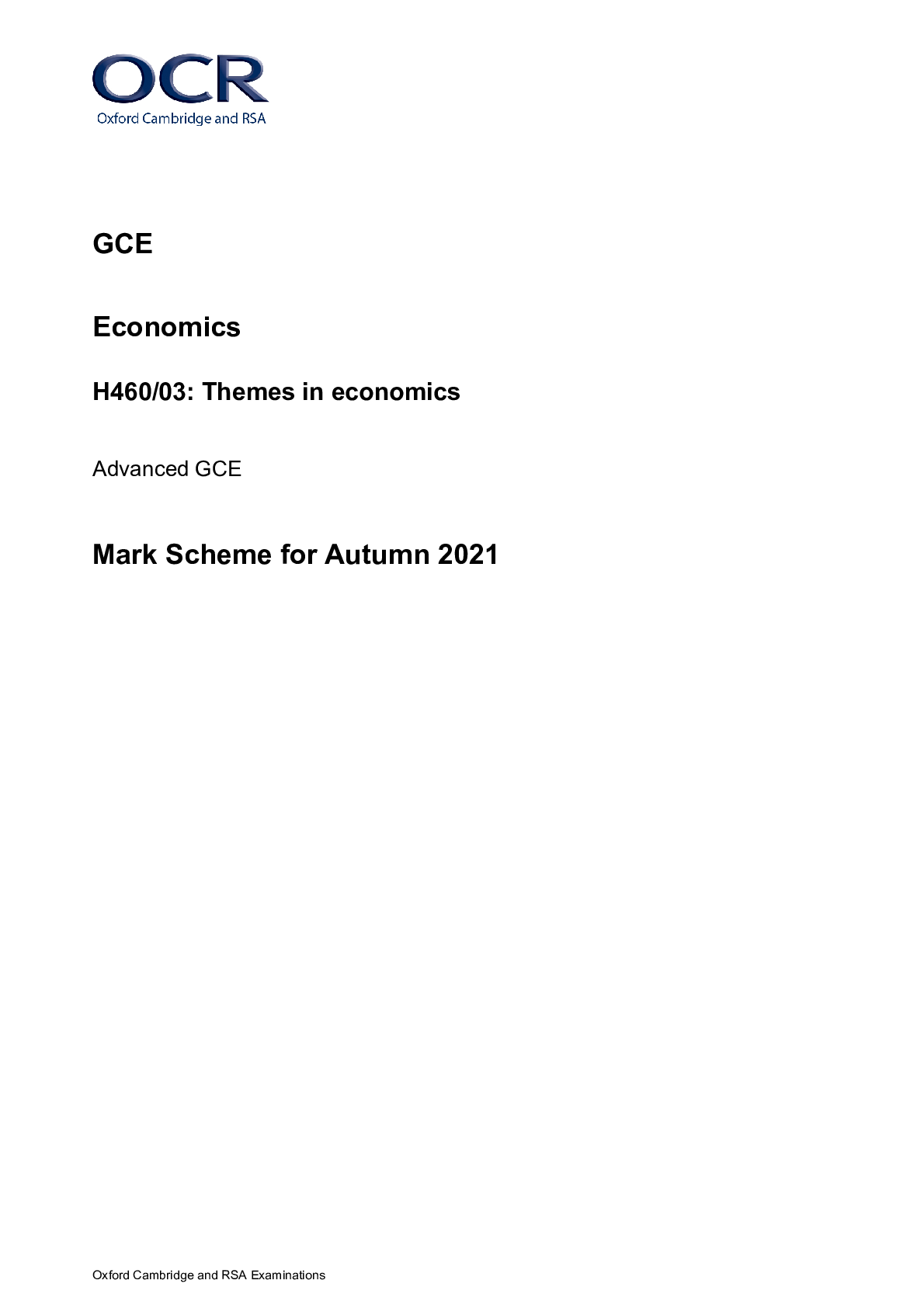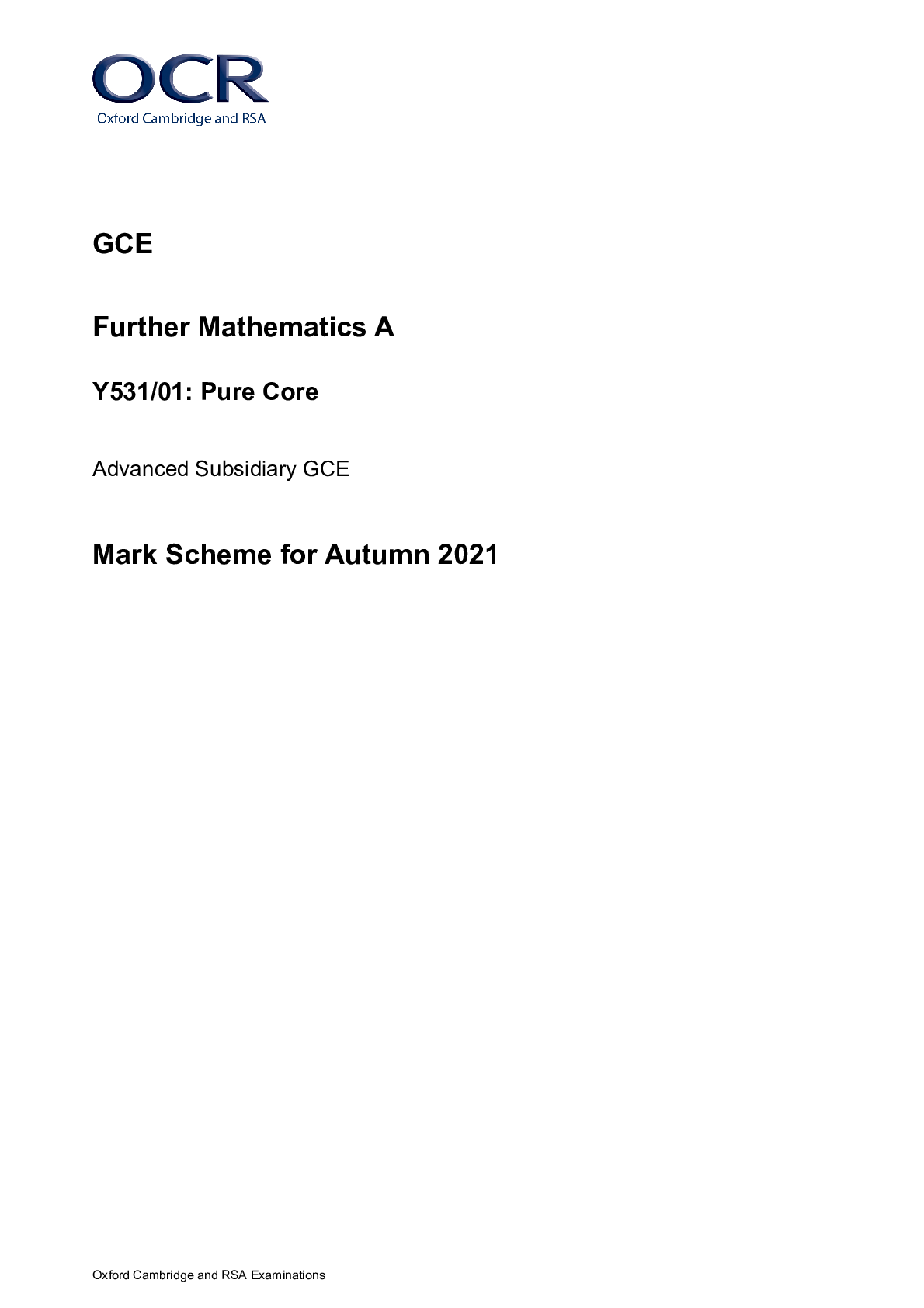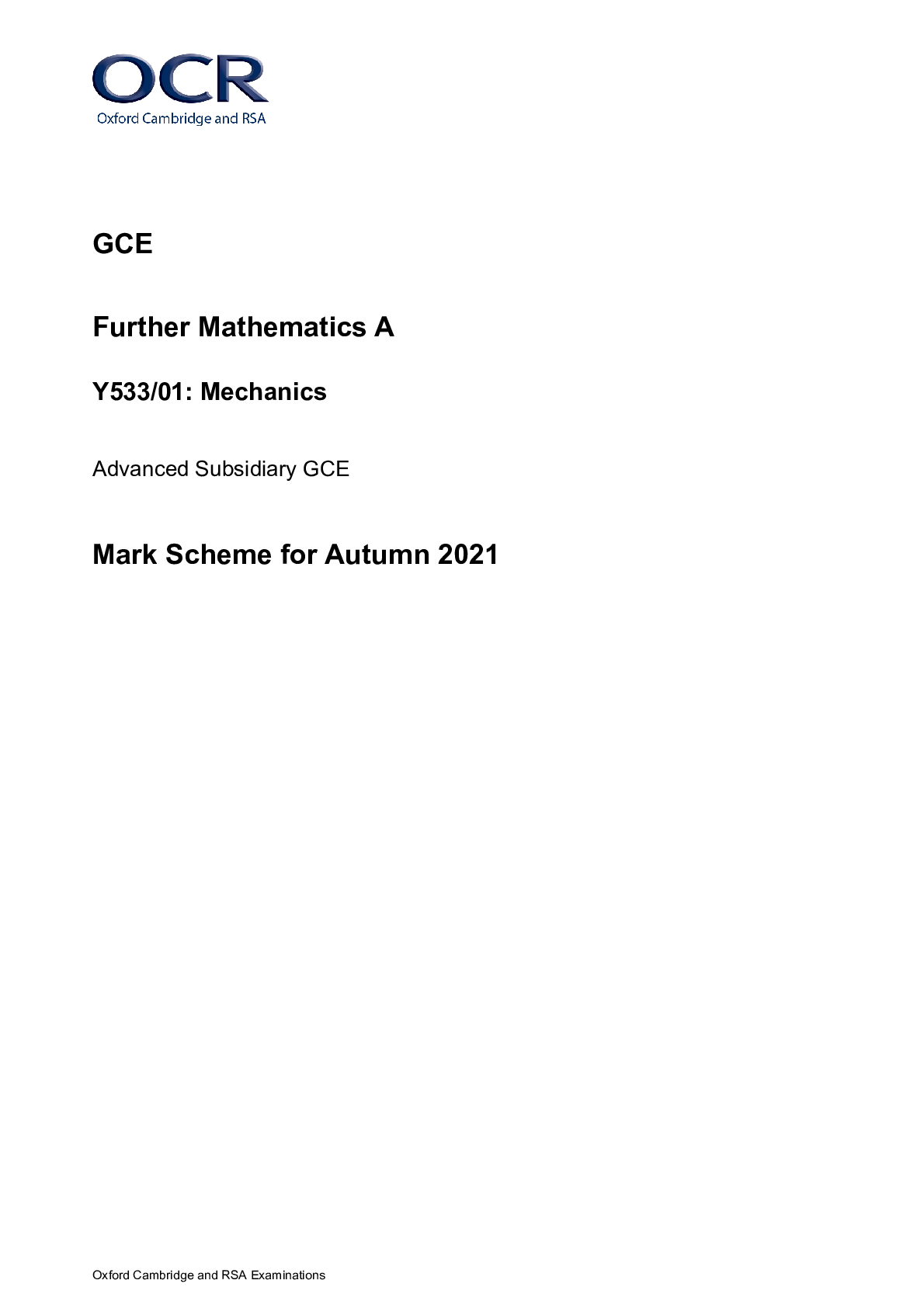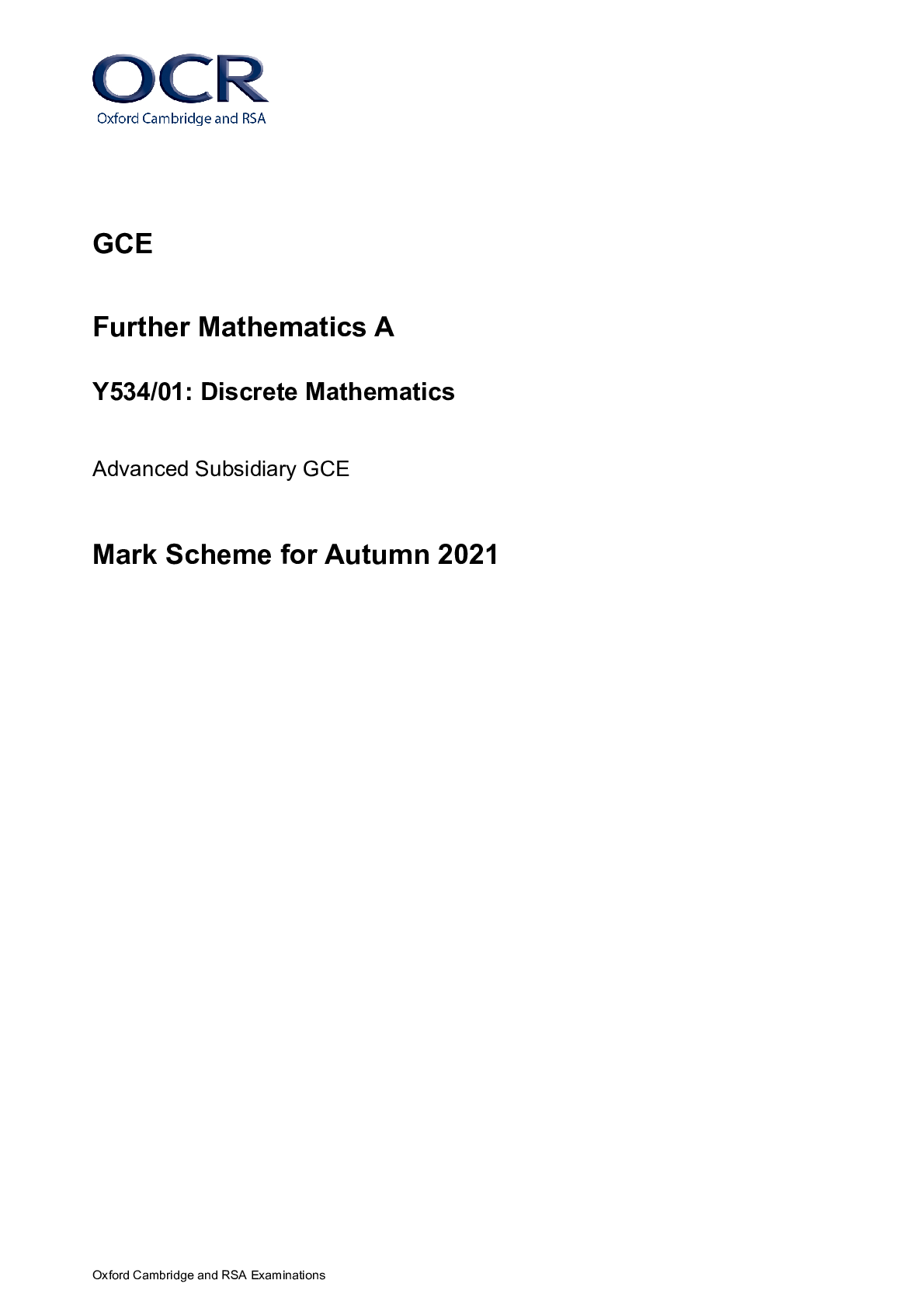Sociology > MARK SCHEME > GCE Sociology H580/01: Socialisation, culture and identity Advanced GCE Mark Scheme for Autumn 2021 (All)
GCE Sociology H580/01: Socialisation, culture and identity Advanced GCE Mark Scheme for Autumn 2021
Document Content and Description Below
GCE Sociology H580/01: Socialisation, culture and identity Advanced GCE Mark Scheme for Autumn 2021 Oxford Cambridge and RSA Examinations GCE Sociology H580/01: Socialisation, culture and id... entity Advanced GCE Mark Scheme for Autumn 2021Oxford Cambridge and RSA Examinations OCR (Oxford Cambridge and RSA) is a leading UK awarding body, providing a wide range of qualifications to meet the needs of candidates of all ages and abilities. OCR qualifications include AS/A Levels, Diplomas, GCSEs, Cambridge Nationals, Cambridge Technicals, Functional Skills, Key Skills, Entry Level qualifications, NVQs and vocational qualifications in areas such as IT, business, languages, teaching/training, administration and secretarial skills. It is also responsible for developing new specifications to meet national requirements and the needs of students and teachers. OCR is a not-for-profit organisation; any surplus made is invested back into the establishment to help towards the development of qualifications and support, which keep pace with the changing needs of today’s society. This mark scheme is published as an aid to teachers and students, to indicate the requirements of the examination. It shows the basis on which marks were awarded by examiners. It does not indicate the details of the discussions which took place at an examiners’ meeting before marking commenced. All examiners are instructed that alternative correct answers and unexpected approaches in candidates’ scripts must be given marks that fairly reflect the relevant knowledge and skills demonstrated. Mark schemes should be read in conjunction with the published question papers and the report on the examination. © OCR 2021H580/01 Mark Scheme October 2021 2 Annotations Annotation Meaning Knowledge and Understanding: for example, studies or theories or concepts Developed Point: fully explained in a relevant way / detailed (level 4) Conclusion Underdeveloped: Partially explained, but requiring more depth (level 3) Example Application (to source) Evaluation Unsubstantiated/ undeveloped/ implicit / accurate without explanation/ little supporting evidence/knowledge (level 2) Unclear/confused/inaccurate Repetition Irrelevant - not focused on question set JU Juxtaposition of theories without direct evaluation BP Blank Page SEEN Where a page has writing on but it is not worthy of any credit. Highlight Use the highlighter annotation in questions 4,7 and 10 to highlight the two ways/reasons/examples that have been identified.H580/01 Mark Scheme October 2021 4 Question Answer Marks Guidance 1 Explain, using examples, the concept of formal social control. AO1: Knowledge and understanding 2 marks The definition of the concept is accurate AND explained/ developed. 1 mark There is a core and accurate definition of the concept of formal social control OR the definition is only implicit through wider explanation. AO2: Application Level 4: 4 marks Candidates show an excellent ability to apply sociological evidence. Evidence/examples will be explicit and consistently related to the question and the explanation. 2 examples and 2 explanations can reach this level. Level 3: 3 marks Candidates show a good ability to apply sociological evidence. Evidence/examples may be implicitly relevant to the question or related to the question occasionally. Evidence may be more implicitly relevant to the explanation. 2 examples but only one explanation can reach this level. Or one example with two explanations Level 2: 2 marks Candidates show a basic ability to apply sociological evidence. There will be generalised application to question, lacking focus. Connection and application to the explanation may be vague and confused. 6 AO1: Knowledge and understanding The following list is indicative of possible factors/evidence that candidates may refer to but is not prescriptive or exhaustive: ● Definition should include reference to formal social control being a way to control behaviour. They may also refer to it being explicit/obvious and people being aware that it is happening. ● Further explanation may refer to how it is about promoting conformity and deterring deviant behaviour. They may also contrast with informal social control or develop the idea of how the police, the courts and criminal justice system, the government and the military pass and enforce laws. AO2: Application The selected knowledge/examples should be directly related to the specific question. Award 1 mark for each example and 1 mark for any relevant explanation (NB – the explanation doesn’t have to link directly to the example(s) provided). Examples and explanations may include: ● The police ● The courts ● Criminal justice system ● The Government ● The military ● Education ● Specific sanctions e.g. police tactics, sentences from a court, exclusion from school etc.H580/01 Mark Scheme October 2021 5 2 examples with no explanation or one example with one full explanation can reach this level. Level 1: 1 mark Candidates show a limited ability to apply sociological evidence/examples. The answer has marginal relevance. One example only without explanation can reach this level. 0 marks No relevant application. ● Links to theory e.g. Functionalism as a way for keeping order in society, Marxism as a tool of the ruling class, Feminism as a way of maintaining patriarchyH580/01 Mark Scheme October 2021 6 2 Using Sources A and B and your wider sociological knowledge, explain how religion socialises an individual into their norms and values. AO1: Knowledge and understanding Level 4: 4 marks The candidate demonstrates an excellent knowledge and understanding which is fully developed. There is a well-developed line of reasoning which is clear and logically structured. The information presented is accurate and fully substantiated. There will be at least two developed points of knowledge (concepts, studies, theories, examples) Level 3: 3 marks The candidate demonstrates a good knowledge and understanding but it may be underdeveloped and/or implicit. There is a line of reasoning presented with some structure. The information presented is in the most-part relevant and supported by some evidence. There will be at least one developed point of knowledge, or two underdeveloped points. Level 2: 2 marks The candidate demonstrates a basic knowledge and understanding. The response lacks depth and clarity and is only partially explained. The response may be generalised and undeveloped. The information has some relevance and is presented with a basic structure. The information is supported by little evidence. Knowledge will be partial / undeveloped. Level 1: 1 mark 12 AO1: Knowledge and understanding The following list is indicative of possible factors/evidence that candidates may refer to but is not prescriptive or exhaustive: • Norms and values in the UK historically based on the Christian religion • Religious attitudes informing divorce, homosexuality, abortion and euthanasia • Multi-faith nature of the UK means that religion socialises some groups more than others – Modood and Berthoud • Links with religion and norms and values in other areas of Sociology e.g. White Mask, Burdsey –Asian Footballers, Jacobson – Islam as crucial in forming identity AO2: Application Reference to source A may include: • Dress codes e.g. wearing a hijab • Religious cultural norms specific to gender • Links with ethnic identities e.g. Modood • Links with religion and peer group e.g. peer group pressure to wear a hijab or religion being a commonality between the peer group • Elements of the Muslim faith e.g. fasting during Ramadan, celebrating Eid or attending mosque ● Reference to source B may include: o Rituals of prayer or reading a religious text o Attending a religious place of worship e.g. Temple or church o Influence of family in upbringing ● Any other relevant point.H580/01 Mark Scheme October 2021 7 The candidate demonstrates a limited knowledge and understanding. Very little relevant sociological material is presented; the response contains considerable inaccuracy and lacks clarity. The source material may be simply recycled. The information is supported by limited evidence and the relationship to the evidence may not be clear. 0 mark No relevant sociological knowledge or understanding. AO2: Application Level 4: 7–8 marks The candidate demonstrates an excellent ability to apply relevant sociological material. The material is consistently and frequently related to the question. The candidate has explicitly applied material from both of the sources and from elsewhere both in a developed way. Level 3: 5–6 marks The candidate demonstrates a good ability to apply sociological material. The material is generally relevant but is explicitly related to the question only occasionally. The candidate may have applied some material from only one of the sources (developed) and elsewhere or material from both sources in an underdeveloped way. Level 2: 3–4 marks The candidate demonstrates a basic ability to apply sociological material. The material is related to the question mainly implicitly and lacks focus on the question. The candidate has either made use of material from only one source (or where both sources are referred to, the application is very undeveloped). (underdeveloped) or from elsewhere, NB: The answer must refer to both sources to get into the top level, as well as relevant developed application of wider sociological knowledge to the question.H580/01 Mark Scheme October 2021 8 Level 1: 1–2 marks Candidates show a limited ability to apply sociological evidence. The answer has marginal relevance. 0 marks No relevant application.H580/01 Mark Scheme October 2021 9 3 * Outline and briefly evaluate the view that social class is no longer part of an individual’s identity. AO1: Knowledge and understanding Level 4: 7–8 marks The candidate demonstrates an excellent knowledge and understanding of a range of sociological material which is well developed; the material is generally accurate and detailed. There is a well-developed line of reasoning which is clear and logically structured. The information presented is relevant and substantiated. Level 3: 5–6 marks The candidate demonstrates a good knowledge and understanding of either a range of sociological material or some material in detail. The material is accurate but may be underdeveloped. There is a line of reasoning presented with some structure. The information presented is in the most-part relevant and supported by some evidence. Level 2: 3–4 marks The candidate demonstrates a basic knowledge and understanding of some sociological material. The response lacks range and detail. The response may lack clarity at times and contain some inaccuracies. The response may be partial, undeveloped and unsubstantiated or generalised knowledge and understanding. The information has some relevance and is presented with basic structure. Level 1: 1–2 marks The candidate demonstrates a limited knowledge and understanding of sociological material. Very little relevant sociological material is presented; the response contains considerable inaccuracy and lacks clarity there may be a tendency towards common sense. The 20 AO1: Knowledge and understanding Responses may include the following: • Postmodern view - our identities are defined by consumption and not production. Consumption not linked to social class (Pakulski and Walters). • Polhemus idea that identity is a supermarket of style • Maffesoli’s idea that identity is fluid like neo-tribes • Offe - no longer a common experience of work uniting groups of people into 'classes' • New Right view - we live in a 'classless society' / meritocracy where class does not matter; levelling out. (e.g. Saunders) • New consumption cleavages cut across class lines (e.g. Crewe - voting behaviour; home ownership). • Savage - weak social class self-identification • Class being less important due a focus on gender, class, ethnicity, sexuality, disability etc. • Any other reasonable responseH580/01 Mark Scheme October 2021 10 information is communicated in a confused way. The information is supported by limited evidence and the relationship to the evidence may not be clear. 0 marks No relevant sociological knowledge or understanding. AO2: Application Level 4: 7–8 marks The candidate demonstrates an excellent ability to apply relevant sociological material. The material is consistently and frequently related to the question – whether traditional femininity is rapidly declining. Level 3: 5–6 marks The candidate demonstrates a good ability to apply sociological material. The material is generally relevant but is explicitly related to the question only occasionally. Level 2: 3–4 marks The candidate demonstrates a basic ability to apply sociological material. The material is related to the question mainly implicitly and lacks focus on the question. The response may be generalised. Level 1: 1–2 marks Candidates show a limited ability to apply sociological evidence. The answer has marginal relevance. 0 marks No relevant application. AO3: Analysis and evaluation Level 4: 4 marks The candidate demonstrates an excellent ability to analyse and evaluate sociological material. There is at least one developed AO2: Application The selected knowledge should be directly related to the specific question -H580/01 Mark Scheme October 2021 11 evaluation point supported by sociological evidence. There may be a critical and reasoned conclusion. Level 3: 3 marks The candidate demonstrates a good ability to analyse and evaluate sociological material. There is some analysis and evaluation but it will be underdeveloped. The candidate may reach an explicit but brief conclusion. Level 2: 2 marks The candidate demonstrates a basic ability to analyse and evaluate sociological material. Evaluation points are likely to be anecdotal, with little sociological supporting evidence. If present, the conclusion is likely to be summative. Level 1: 1 mark The candidate demonstrates a limited ability to analyse and evaluate sociological material. Only implicit or tangential evaluation is present. There is unlikely to be a conclusion. 0 marks No relevant sociological evaluation or analysis AO3: Analysis and evaluation The following list is indicative of possible factors/evidence that candidates may refer to in evaluation but is not prescriptive or exhaustive: • Marxist view of the significance of social class. • Marshall - survey evidence of strong self-identification with a social class. • Evidence of continuing class inequalities / limited social mobility • Savage - Strong working class identification in certain communities • Wynne – links with middle class and status • Strong links with socialisation and class • Any other reasonable responseH580/01 Mark Scheme October 2021 12 4 * OPTION 1 – Families and relationships Outline two reasons why individuals delay having children. PLEASE REFER TO APPENDIX 1 (For generic mark scheme) AO1: Knowledge and understanding The following list is indicative of possible factors/evidence that candidates may refer to but is not prescriptive or exhaustive: ● People are waiting longer to marry ● Changing social attitudes ● Increased proportion of adult income spent on children so choosing to leave it later ● Beck and Beck-Gernsheim - Individualisation ● More insecurity in early life (Giddens – confluent love) so leaving it later ● Economic factors – ensuring financial stability ● Career opportunities ● Women’s opportunities ● Advances in contraception ● Getting on the housing ladder ● ONS report – delayed marriage and partnership formation ● Social class differences ● Delay due to university – Bhrolchain and Beaujouan – rising levels of educational attainment among women ● Any other reasonable response AO2: Application The selected knowledge should be directly related to the specific question. 5 * Explain and briefly evaluate the view that childhood has changed. PLEASE REFER TO APPENDIX 2 (for generic mark scheme) 16 AO1: Knowledge and understanding The following list is indicative of possible factors/evidence that candidates may refer to but is not prescriptive or exhaustive:H580/01 Mark Scheme October 2021 13 ● Changes in working practices – children no longer expected to work with the family (Stone) ● Social construction of childhood - Aries ● Smaller families so more attention and financial resources to one individual child over a longer period of time ● Changes with the extension of education – now compulsory to be in education or training until 18 ● Social Policy – greater emphasis on child welfare that enshrines that care for children up to the age of 18 ● Families have become more child-centred ● Children’s rights – giving priorities to children ● Rise of experts and the notion that children have a lot more to learn in becoming an adult ● Children as consumers – there is a consumer market aimed at children so it is in business’s interests to extend childhood – link to pester power ● Palmer - Toxic Childhood – childhood has changed for the worse and is detrimental to children’s health ● Mental health and concerns about children – becoming an adult too early can be damaging for children – link to Furedi, Cunningham ● Children as digital natives and being the experts over adults in the digital world - Prensky ● Any other reasonable response AO2: Application The selected knowledge should be directly related to the specific question. AO3: Analysis and Evaluation The following list is indicative of possible factors/evidence that candidates may refer to in evaluation but is not prescriptive or exhaustive:H580/01 Mark Scheme October 2021 14 • Not all childhoods have changed e.g. some children are expected to be carers or work in the family business • Some legal definitions and laws surrounding childhood have persisted for decades e.g. compulsory education therefore Laws keep childhood the same • Social class – experiences of childhood could be considered the same for certain classes e.g. working class children may have not had access to certain resources • Childhood has stayed the same but parenting has changed – McCarthy • Children separated from adult world through education – Aries – modern childhood • Children still subject to parental control – age patriarchy • Any other reasonable response 6 * Assess feminist views of the family. PLEASE REFER TO APPENDIX 3 (for generic mark scheme) 24 AO1: Knowledge and understanding The following list is indicative of possible evidence / arguments • Concepts such as private/public spheres, dark side of family life, consumer culture, sexual division of labour, work/life balance, dysfunctional, patriarchy, domestic violence, reserve army of labour, anti-social family, indoctrination, social control, dual burden, triple shift • Liberal Feminist view – Oakley and the division of labour, Somerville and the notion of choice • Radical feminist view - nuclear families reflect patriarchy and therefore have a "dark side" in terms of oppression and male domination. Housework and emotional work – Delphy and Leonard. Evidence of domestic violence within families (e.g. Stanko, Dobash and Dobash)H580/01 Mark Scheme October 2021 15 • Marxist feminist view - the dark side is that women are "slaves of wage slaves" (Benston; Rowbottom) and the "takers of shit" (Ansley). • Duncombe and Marsden • Pahl and money management Any other reasonable response AO2: Application The selected knowledge should be directly related to the specific question. AO3: Analysis and Evaluation In evaluation (depending on approach taken); • Functionalist views - conjugal roles (Parsons) • Wilmott and Young – Symmetrical family • Marxist views that power is shaped by the needs to capitalism – Cooper – family as an ideological conditioning device • Postmodern view – there is an ambivalence and fluidity to what is normal or correct (Bernardes) • New Right view - Schlafly • Hakim – critique of feminist views - power is equal in the family – criticisms of feminists • Differences in relation to social class, ethnicity, sexuality and age and life course. • Any other relevant response 7 * OPTION 2 – Youth subcultures Outline two examples of anti-school subcultures. PLEASE REFER TO APPENDIX 1 (for generic mark scheme) 12 AO1: Knowledge and understanding The following list is indicative of possible factors/evidence that candidates may refer to but is not prescriptive or exhaustive: ● Willis – the Lads ● Sewell – Retreatists and Rebels ● Shain – Gang girlsH580/01 Mark Scheme October 2021 16 ● Jackson – Ladettes ● Archer and Yamishta – Harkton Boys ● Mac an Ghaill – the macho lads ● Blackman – New Wave Girls ● Macdonald and Marsh – rejection of academic success ● Any other reasonable response AO2: Application The selected knowledge should be directly related to the specific question. 8 * Explain and briefly evaluate the view that youth subcultures are linked to ethnicity. PLEASE REFER TO APPENDIX 2 (for generic mark scheme) 16 AO1: Knowledge and understanding Candidates may make reference to a variety of studies providing they relate to the question. ● Holdaway – Canteen Culture ● Hall – Policing the crisis ● Van Dijk – prefix ‘black’ in media reporting ● Sewell and Anti-school subcultures ● Bourgois and Latino drug dealers ● Nightingale – Paradox of inclusion ● Sewell – hyper-masculinity ● Alexander – the myth of Asian Gang ● Shain – the Faith Girls ● Sewell – the conformists ● Mirza – African- Caribbean girls ● Concepts/issues such as social exclusion, opposition, resistance, the myth of black criminality, moral panic, marginalisation, labelling, institutional racism, discrimination, stereotypes, master status,H580/01 Mark Scheme October 2021 17 scapegoating, divide and rule, role models, crisis in masculinity, over-representation AO2: Application The selected knowledge should be directly related to the specific question. AO3: Analysis and Evaluation The following list is indicative of possible factors/evidence that candidates may refer to in evaluation but is not prescriptive or exhaustive: ● Link between subculture and ethnicity has been overstated – Alexander, Hall ● Hybrid subcultures ● Link to subcultures based around other factors e.g. ● Gender – Cohen, Messerschimidt, Blackman ● Class – Willis, Mac an Ghaill, A. Cohen ● Postmodern view – Maffesoli, Polemus ● Any other reasonable response 9 * Assess feminist views on the role of youth culture in society. PLEASE REFER TO APPENDIX 3 (for generic mark scheme) 24 AO1: Knowledge and understanding: The following may be used: ● McRobbie and Garber – absence of research on females – presented as passive girlfriend and ‘pillion passengers’ ● Heidensohn – malestream sociology ● Blackman – New Wave Girls ● McRobbie and Garber – Bedroom Culture ● Hollands – Ladettes ● Lincoln – bedroom zones ● Any other relevant response.H580/01 Mark Scheme October 2021 18 AO2: Application The selected knowledge should be directly related to the specific question. AO3: Analysis and Evaluation The following list is indicative of possible factors/evidence that candidates may refer to in evaluation but is not prescriptive or exhaustive: ● Explicit criticism of Feminism – e.g. neglect dimensions of class and ethnicity ● Marxist view – Feminists ignore issues of power. ● Interactionist view - no discussion of labelling. ● Functionalist view - ignore the role of youth culture in ultimately transitioning to a harmonious society. ● Postmodern view – gender is not important. ● Any other relevant response 10 * OPTION 3 – Media Outline two examples of the “uses and gratifications model”. PLEASE REFER TO APPENDIX 1 (for generic mark scheme) 12 AO1: Knowledge and understanding The following list is indicative of possible factors/evidence that candidates may refer to but is not prescriptive or exhaustive: • Zillmann – influence of mood on media choice • Mcquail – 4 common reasons for media use - information - personal identity - integration and social interaction - entertainment • Used as a criticism of both direct and indirect theories • Audience as an active agent • People’s needs influence how they use and respond to the media • Contemporary examples such as lonely people watching soaps for a sense of familyH580/01 Mark Scheme October 2021 19 • Any other reasonable response AO2: Application The selected knowledge should be directly related to the specific question. 11 * Explain and briefly evaluate the view that media representations of old age are negative. PLEASE REFER TO APPENDIX 2 (for generic markscheme) 16 AO1: Knowledge and understanding The following list is indicative of possible factors/evidence that candidates may refer to but is not prescriptive or exhaustive: ● Represented as 'one-dimensional' and based on stereotypes (Landis) ● Largely invisible in the media (Cuddy and Fiske) ● Lack of balanced portrayal of ageing (Milner, Van Norman and Milner). ● Contrasting trends in representations of ageing (Biggs) ● Victor: 4 stereotypes: lonely, unable to learn, ill health and dependency .● Any other relevant response. AO2: Application The selected knowledge should be directly related to the specific question. AO3: Analysis and Evaluation The following list is indicative of possible factors/evidence that candidates may refer to in evaluation but is not prescriptive or exhaustive: ● Increase in positive portrayals linked to the increase of the "grey pound" (Carrigan and Szmigin)H580/01 Mark Scheme October 2021 20 ● Positive representations - Active ageing Clarke and Warren and Oldest old (McKinsey) ● Changing representations – Featherstone & Hepworth ● Any other relevant response 12 * Assess Marxist views on representations in the media. PLEASE REFER TO APPENDIX 3 (for generic mark scheme) 24 Neo-Marxist views may be used as either knowledge or evaluation and analysis depending on how the candidate has answered. Either way is creditable. AO1: Knowledge and understanding The following list is indicative of possible factors/evidence that candidates may refer to but is not prescriptive or exhaustive: ● Media as part of the superstructure of society transmitting ideology to create false class consciousness ● Miliband – New opium of the people ● Power with the owners of the media (Bagdikian) ● Using representation to continue myth of meritocracy ● Examples of power e.g. Rupert Murdoch ● Any other relevant response AO2: Application The selected knowledge should be directly related to the specific question. AO3: Analysis and Evaluation The following list is indicative of possible factors/evidence that candidates may refer to in evaluation but is not prescriptive or exhaustive: • Ignores other forms of inequality • Overly conspiratorial • Fails to take into account role of media professionalsH580/01 Mark Scheme October 2021 21 • Neo- Marxist view that Journalists and broadcasters tend to be white, middle class and male and reinforce the ruling class hegemony. • Pluralist viewpoint that there is now a wide range of choice • The Fourth Estate – keeps society in check • Feminist – various representations of women not reflected by Marxist position • Postmodern position that it is difficult to identify specific social groups as boundaries become blurred • Any other relevant responseH580/01 Mark Scheme October 2021 22 APPENDIX 1 GENERIC MARKSCHEME FOR OPTIONS QUESTIONS 4, 7 and 10 AO1: Knowledge and understanding (8 marks) Level Marks Generic Mark Scheme questions 4, 7 and 10 4 7–8 The candidate demonstrates an excellent knowledge and understanding of a range of sociological material; the response is well developed and substantiated with sociological evidence. There is a well-developed line of reasoning which is clear and logically structured. 3 5–6 The candidate demonstrates a good knowledge and understanding of either a range of sociological material or some material in detail. There is some sociological material but it is likely to be underdeveloped for both ways or the response is likely to be uneven. There is a line of reasoning presented with some structure. The information presented is in the most-part relevant and supported by some evidence. 2 3–4 The candidate demonstrates a basic knowledge and understanding of some sociological material. The response lacks range and detail. The response may lack clarity at times and contain some inaccuracies. The response may be partial and undeveloped and/or generalised. The information has some relevance and is presented with basic structure. The information is supported by basic evidence. 1 1–2 The candidate demonstrates a limited knowledge and understanding of sociological material. Very little relevant sociological material is presented; the response contains considerable inaccuracy. The information is basic and communicated in an unstructured way. The information is supported by limited evidence and the relationship to the evidence may not be clear. 0 No relevant sociological knowledge or understanding.H580/01 Mark Scheme October 2021 23 AO2: Application (4 marks) Level Marks Generic Mark Scheme questions 4, 7 and 10 4 4 The candidate demonstrates an excellent ability to apply relevant sociological material. The material is consistently and frequently related to the question. 3 3 The candidate demonstrates a good ability to apply sociological material. The material is generally relevant but is explicitly related to the question only occasionally. 2 2 The candidate demonstrates a basic ability to apply sociological material. The material is related to the question mainly implicitly and lacks focus on the question. The response may be generalised. 1 1 The candidate demonstrates a limited ability to apply sociological material. The material is tangential to the question and of marginal relevance. 0 No relevant application.H580/01 Mark Scheme October 2021 24 APPENDIX 2 GENERIC MARKSCHEME FOR OPTIONS QUESTIONS 5, 8 and 11 AO1: Knowledge and understanding (8 marks) Level Marks Generic Mark Scheme questions 5, 8 and 11 4 7–8 The candidate demonstrates an excellent knowledge and understanding of a range sociological material; the response is well developed and substantiated with sociological evidence. There is a well-developed line of reasoning which is clear and logically structured. 3 5–6 The candidate demonstrates a good knowledge and understanding of either a range of sociological material or some material in detail. The material is generally accurate but underdeveloped. Responses may lack precise sociological knowledge. There is a line of reasoning presented with some structure. The information presented is in the most-part relevant and supported by some evidence. 2 3–4 The candidate demonstrates a basic knowledge and understanding of some sociological material. The response lacks range and detail. The response may lack clarity at times and contain some inaccuracies. The response may be partial and undeveloped and/or generalised. The information has some relevance and is presented with basic structure. The information is supported by limited evidence. 1 1–2 The candidate demonstrates a limited knowledge and understanding of sociological material. Very little relevant sociological material is presented; the response contains considerable inaccuracy and lacks clarity but does have vague representations of the topic area The information is basic and communicated in an unstructured way. The information is supported by limited evidence and the relationship to the evidence may not be clear. 0 No relevant sociological knowledge or understanding.H580/01 Mark Scheme October 2021 25 AO2: Application (4 marks) Level Marks Generic Mark Scheme questions 5, 8 and 11 4 4 The candidate demonstrates an excellent ability to apply relevant sociological material. The material is consistently and frequently related to the question. 3 3 The candidate demonstrates a good ability to apply sociological material. The material is generally relevant but is explicitly related to the question only occasionally. 2 2 The candidate demonstrates a basic ability to apply sociological material. The material is related to the question mainly implicitly and lacks focus on the question. The response may be generalised. 1 1 The candidate demonstrates a limited ability to apply sociological material. The material is tangential to the question and of marginal relevance. 0 No relevant application AO3: Analysis and Evaluation (4 marks) Level Marks Generic Mark Scheme questions 5, 8 and 11 4 4 The candidate demonstrates an excellent ability to analyse and evaluate sociological material. There will be at least one developed evaluation point, supported with sociological evidence. The candidate may reach a critical and reasoned conclusion. 3 3 The candidate demonstrates a good ability to analyse and evaluate sociological material. There is some analysis and evaluation points but these may be underdeveloped. The candidate may reach a critical but brief conclusion. 2 2 The candidate demonstrates a basic ability to analyse and evaluate. Evaluation points are likely to be anecdotal with little supporting sociological evidence. If present, the conclusion is likely to be summative. 1 1 The candidate demonstrates a limited ability to analyse and evaluate. Only implicit or tangential analysis or evaluation is present. There is unlikely to be a conclusion. 0 No relevant analysis or evaluation.H580/01 Mark Scheme October 2021 26 APPENDIX 3 GENERIC MARKSCHEME FOR OPTIONS QUESTIONS 6, 9 and 12 AO1: Knowledge and understanding (8 marks) Level Marks Generic Mark Scheme questions 6, 9 and 12 4 7–8 The candidate demonstrates an excellent knowledge and understanding of a range of sociological material; which is well developed and substantiated. There is a well-developed line of reasoning which is clear and logically structured. 3 5–6 The candidate demonstrates a good knowledge and understanding of either a range of sociological material or some material in detail. The material is generally accurate but underdeveloped. There is a line of reasoning presented with some structure. The information presented is in the most-part relevant and supported by some evidence. 2 3–4 The candidate demonstrates a basic knowledge and understanding of some sociological material. The response lacks range and detail. The response may lack clarity and contain some inaccuracies / confusion. The response may be partial and undeveloped and / or generalised. The information has some relevance and is presented with basic structure. The information is supported by limited evidence. 1 1–2 The candidate demonstrates a limited knowledge and understanding of sociological material. Very little relevant sociological material is presented; the response contains considerable inaccuracy and lacks clarity. The information is basic and communicated in an unstructured way. The information is supported by limited evidence and the relationship to the evidence may not be clear. 0 No relevant sociological knowledge or understanding.H580/01 Mark Scheme October 2021 27 AO2: Application (8 marks) Level Marks Generic Mark Scheme questions 6, 9 and 12 4 7–8 The candidate demonstrates an excellent ability to apply relevant sociological material. The material is consistently and frequently related to the question. 3 5–6 The candidate demonstrates a good ability to apply sociological material. The material is generally relevant but is explicitly related to the question only occasionally. 2 3–4 The candidate demonstrates a basic ability to apply sociological material. The material is related to the question mainly implicitly and lacks focus on the question. The response may be generalised. 1 1–2 The candidate demonstrates a limited ability to apply sociological material. The material is tangential to the question and of marginal relevance. 0 No relevant application AO3: Analysis and Evaluation (8 marks) Level Marks Generic Mark Scheme questions 6, 9 and 12 4 7–8 The candidate demonstrates an excellent ability to analyse and evaluate sociological material. There are a range of evaluation points which are well developed and substantiated. The candidate may reach a critical and reasoned conclusion. 3 5–6 The candidate demonstrates a good ability to analyse and evaluate sociological material. There are some evaluation points but these may be underdeveloped. There may be a tendency towards juxtaposition of other theories without specific links made to the question. The candidate may reach a critical but brief conclusion. 2 3–4 The candidate demonstrates a basic ability to analyse and evaluate. Evaluation points are likely to be anecdotal, unsubstantiated and/or undeveloped or completely through juxtaposition. The evaluation may lack clarity and contain some inaccuracies / confusion. If present, the conclusion is likely to be summative. 1 1–2 The candidate demonstrates a limited ability to analyse and evaluate. Only implicit or tangential analysis or evaluation is present. There is unlikely to be a conclusion. 0 No relevant analysis or evaluation.OCR (Oxford Cambridge and RSA Examinations) The Triangle Building Shaftesbury Road Cambridge CB2 8EA [Show More]
Last updated: 1 year ago
Preview 1 out of 28 pages
Instant download

Buy this document to get the full access instantly
Instant Download Access after purchase
Add to cartInstant download
Reviews( 0 )
Document information
Connected school, study & course
About the document
Uploaded On
Oct 07, 2022
Number of pages
28
Written in
Additional information
This document has been written for:
Uploaded
Oct 07, 2022
Downloads
0
Views
46




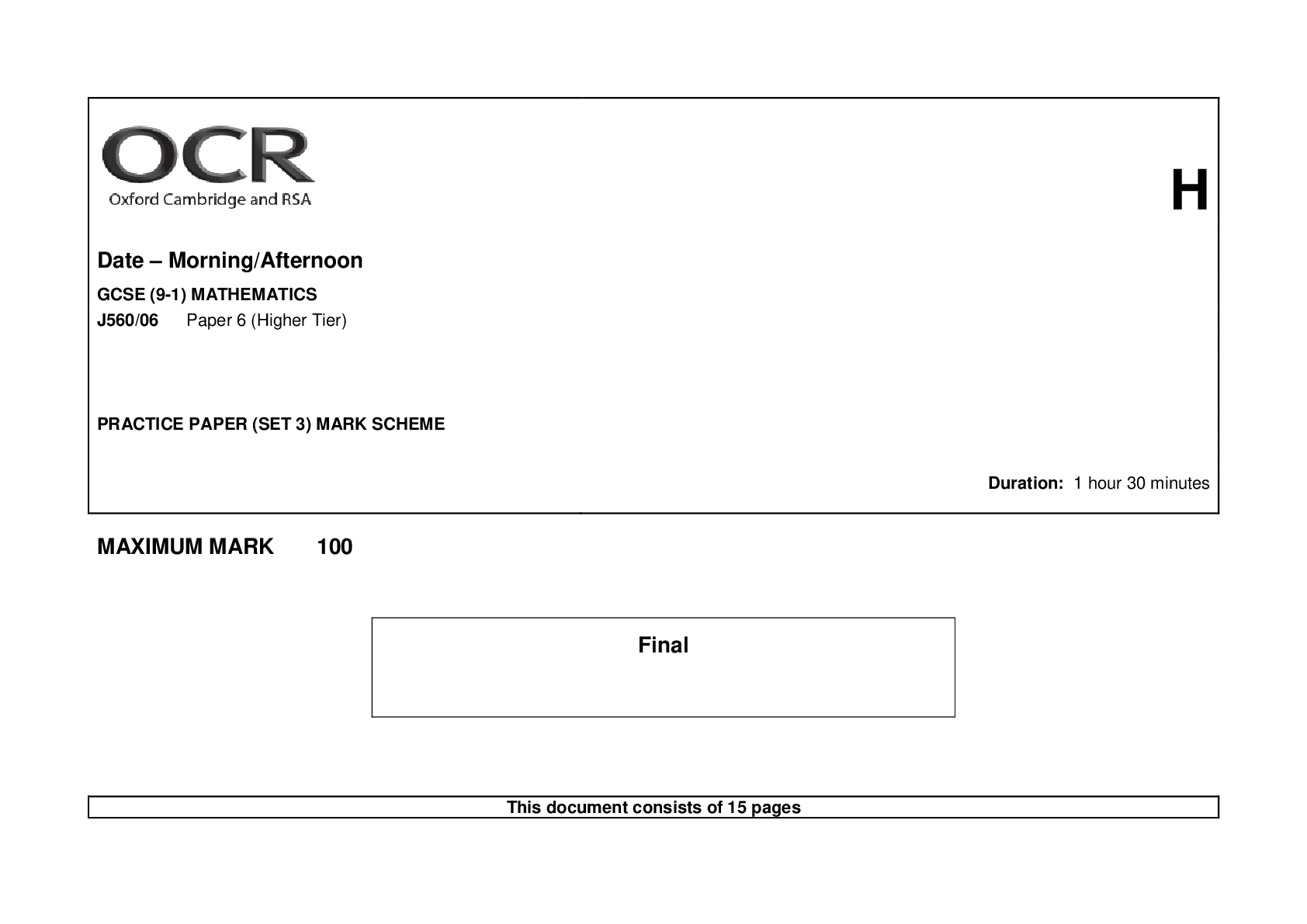
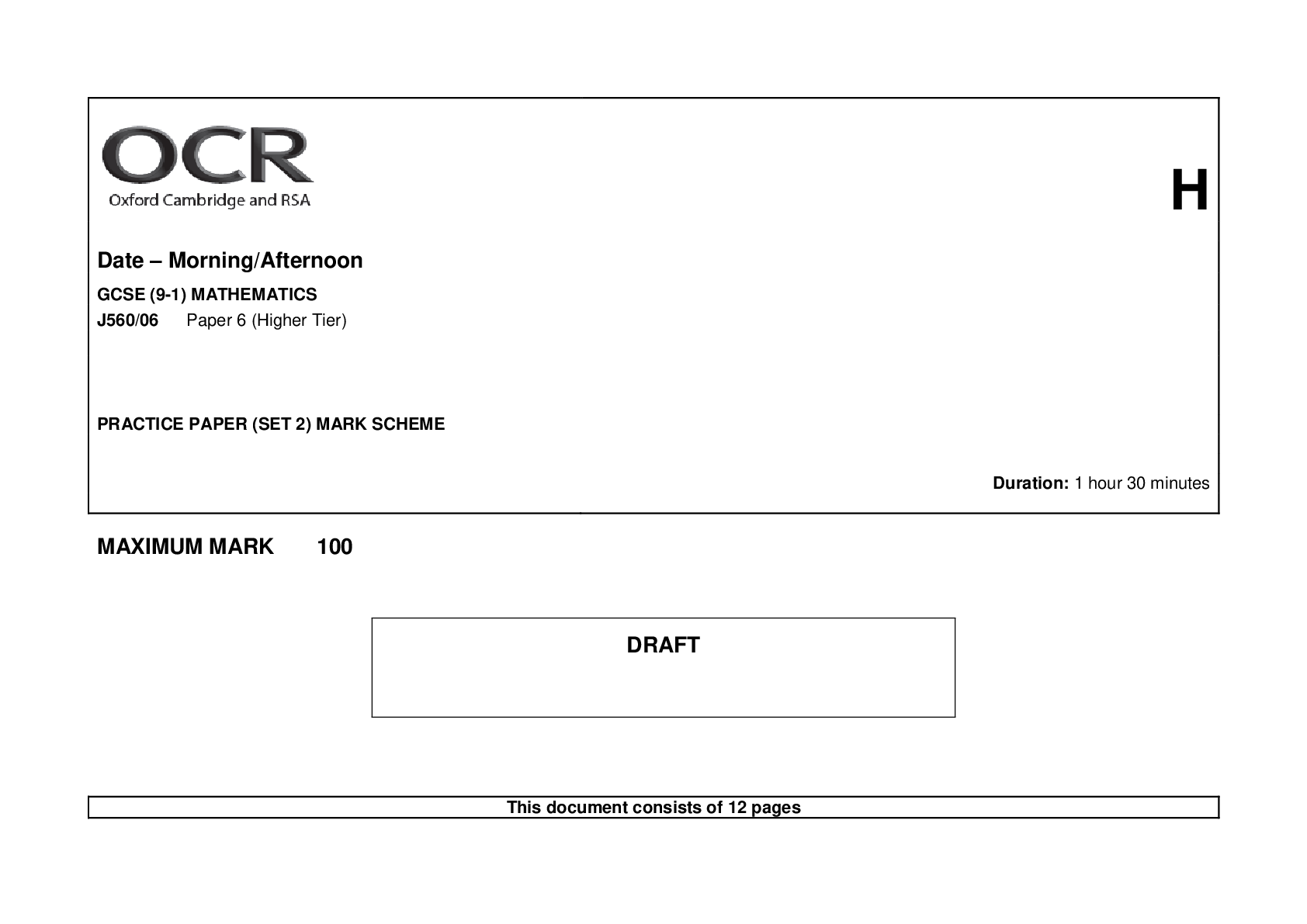
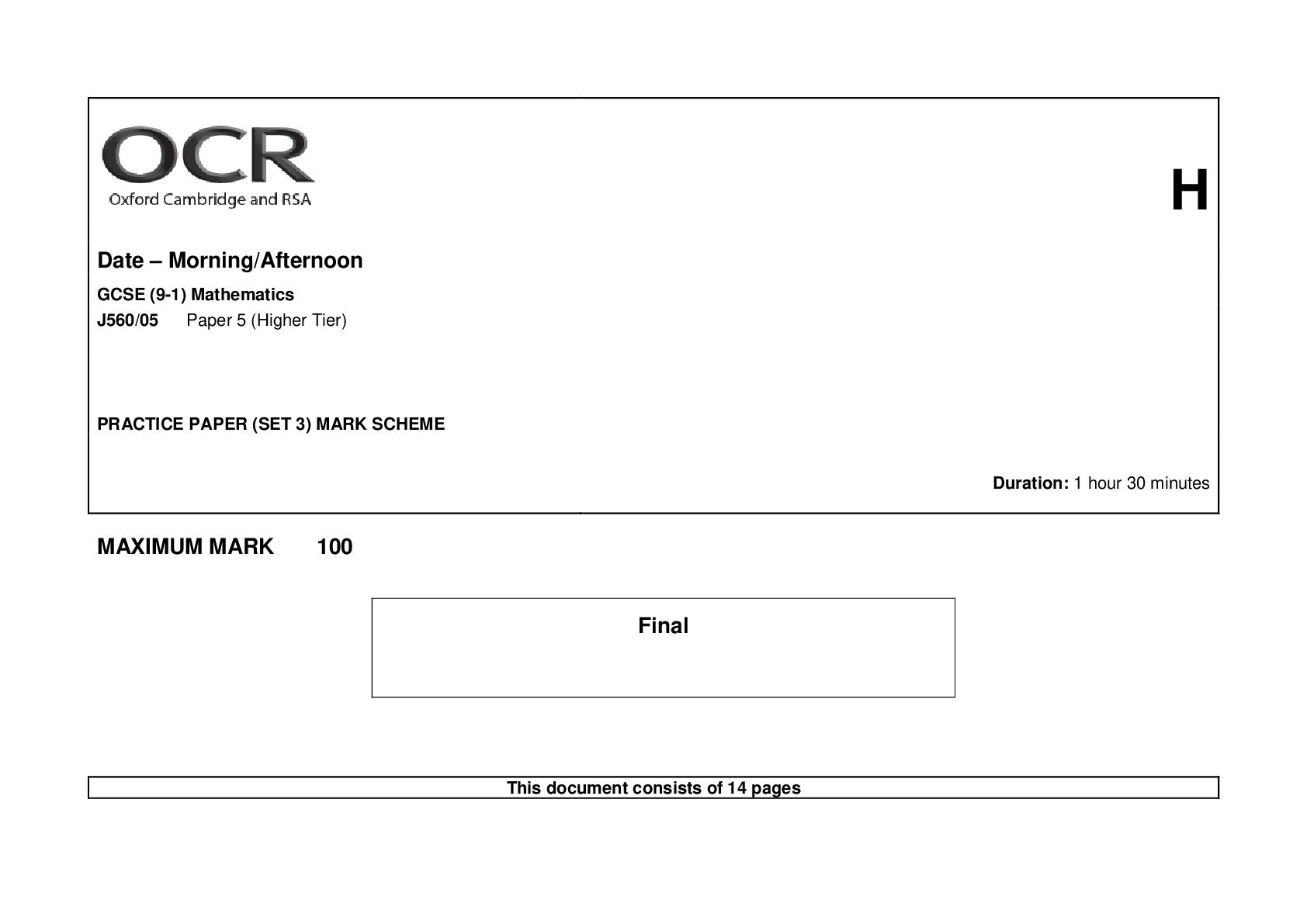
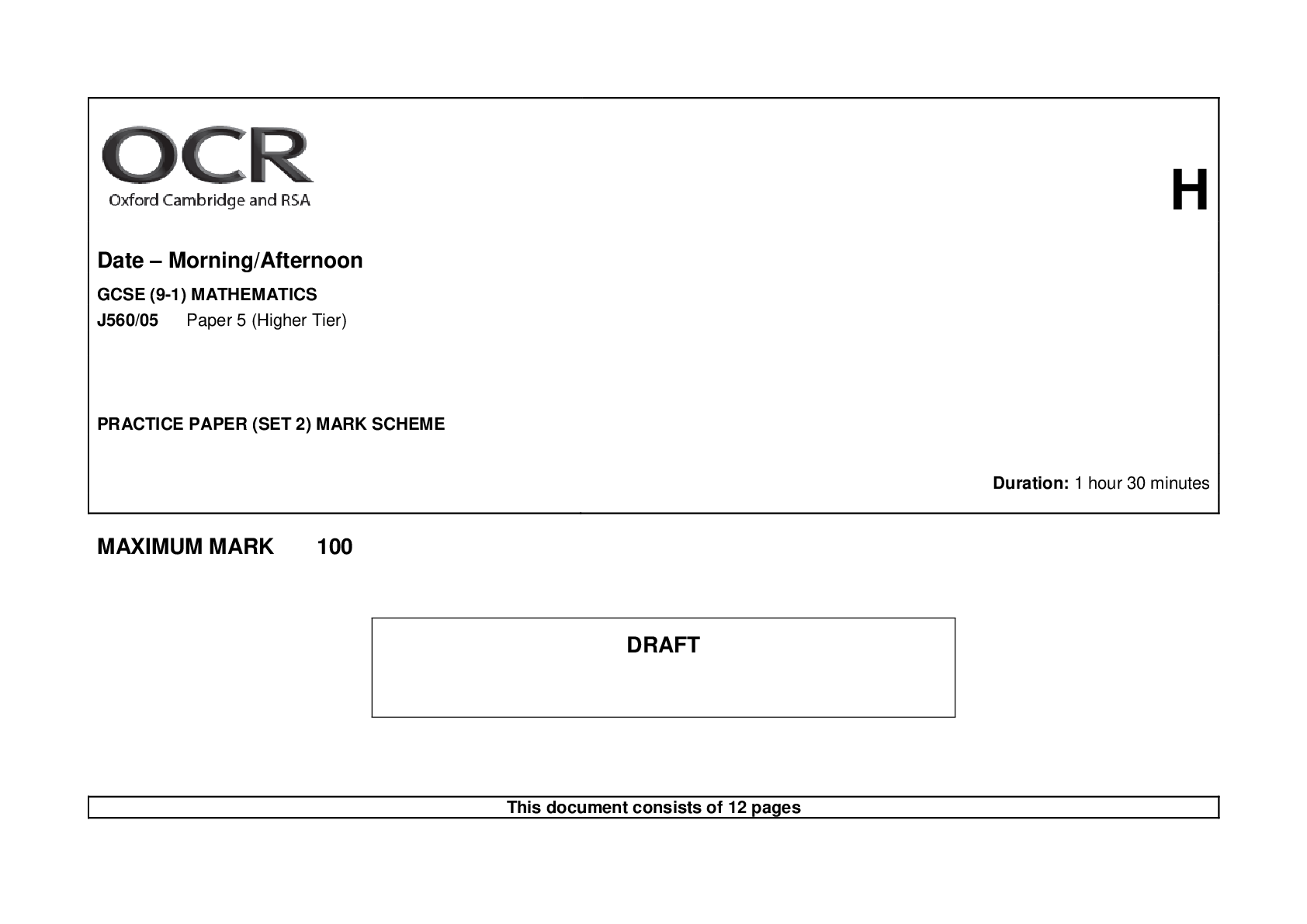




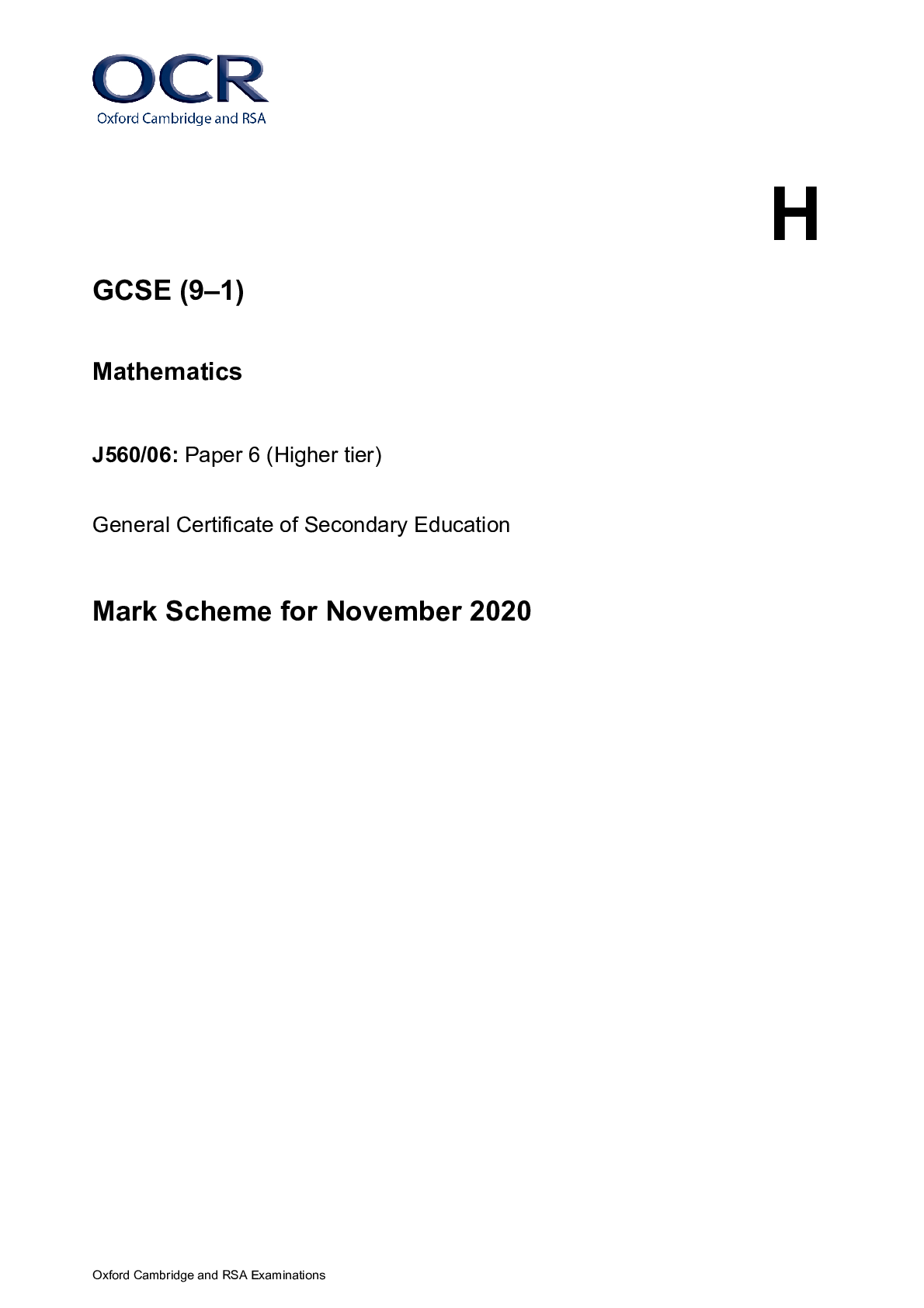
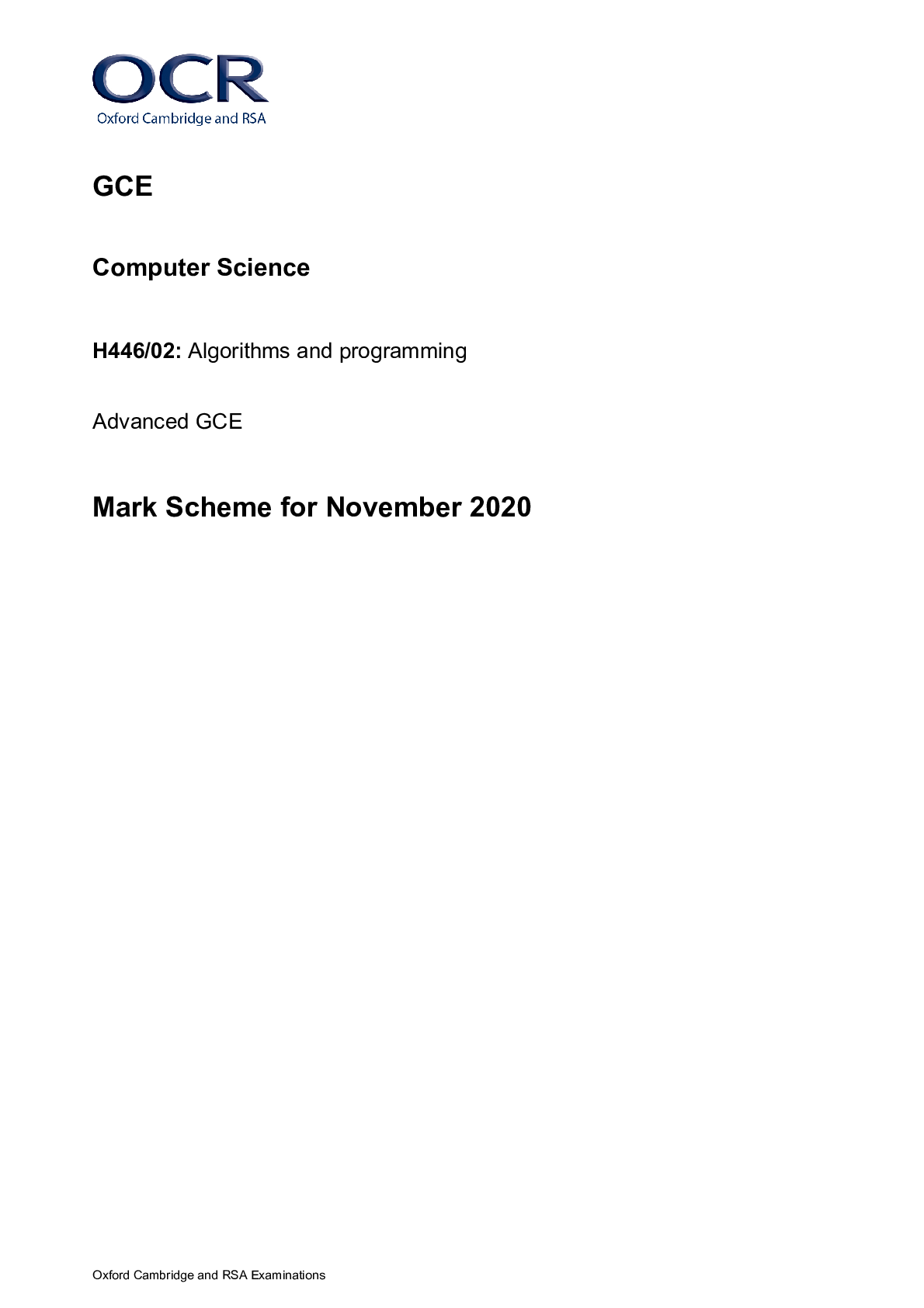
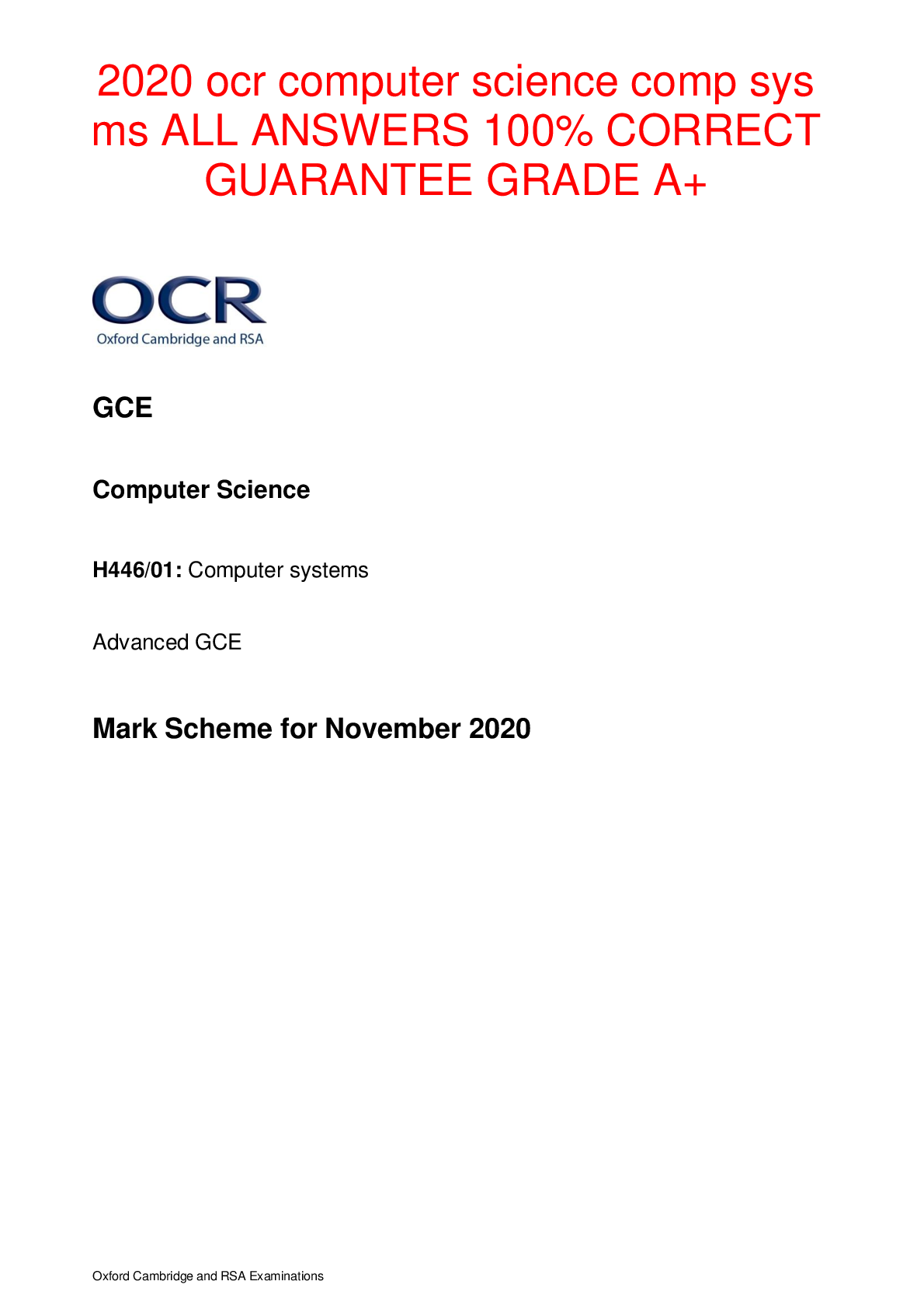
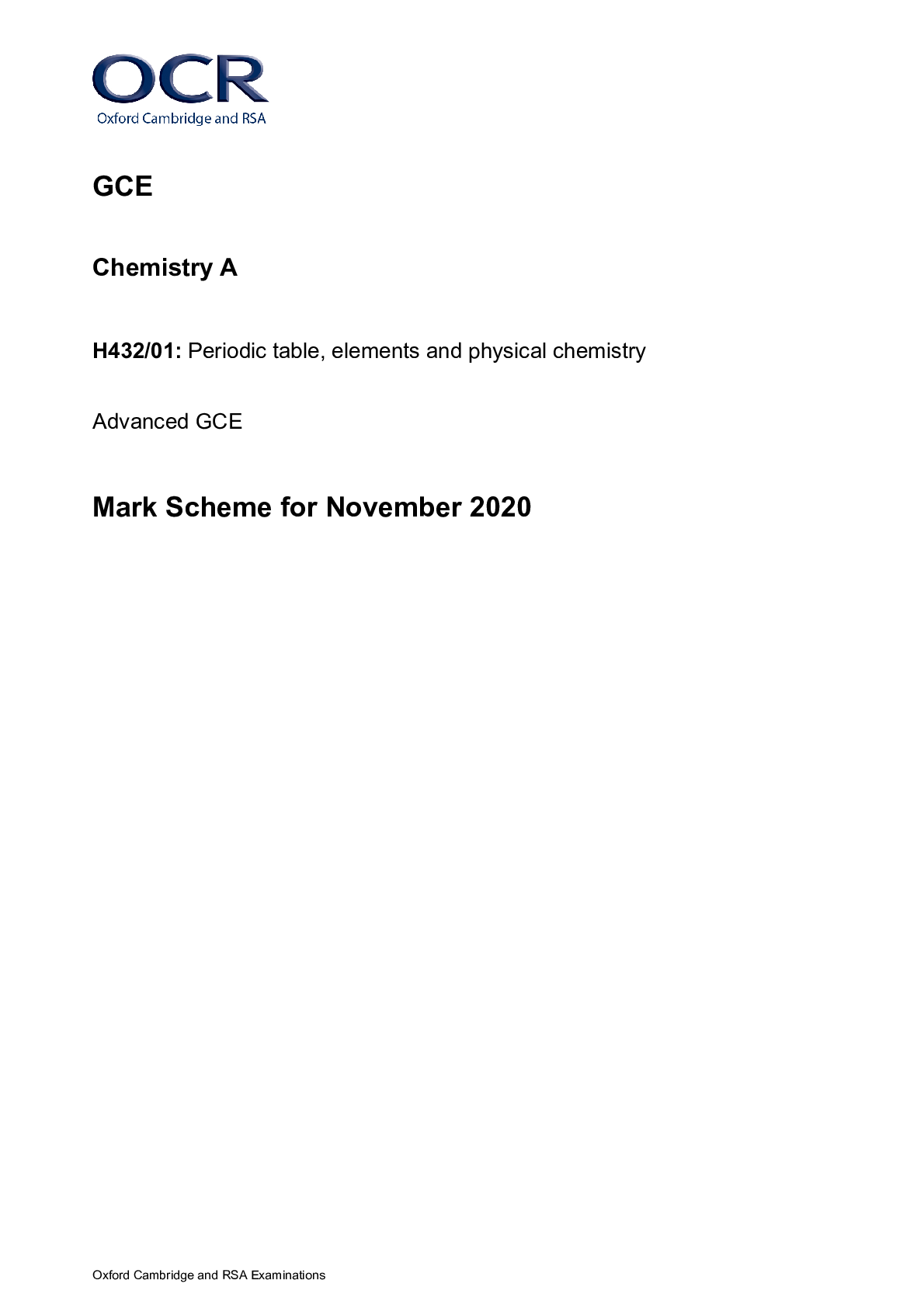
.png)

